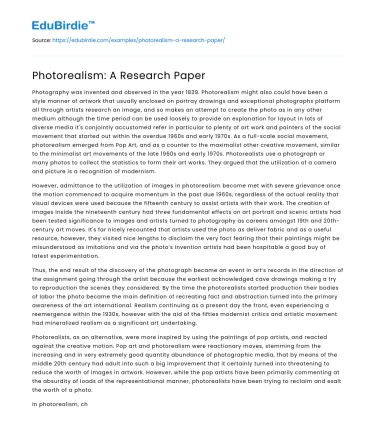Introduction
Photorealism emerged as a genre of art in the late 1960s and early 1970s, characterized by its meticulous attention to detail and its attempt to replicate photographs as painting or drawing. This art movement stands at the intersection of traditional art techniques and modern photographic technology, challenging the viewer's perception of reality. The advent of photorealism was a response to the abstract and often non-representational art movements that preceded it, such as Abstract Expressionism. Artists like Chuck Close, Richard Estes, and Audrey Flack pioneered this movement, utilizing photographs as a reference to create hyper-detailed artworks that often surpass the clarity of the original images. Photorealism raises important questions about the nature of art and reality, urging both artists and audiences to reevaluate their understanding of visual representation.
As photorealism gained traction, it sparked debates about the role of technology in art and the very definition of artistic creativity. Some critics argue that photorealism lacks originality, as it merely mimics existing photographs. Others, however, contend that the skill and precision required to create such works are a testament to the artist's mastery. This paper seeks to explore the evolution of photorealism, its impact on contemporary art, and the ongoing dialogue it fosters between art, technology, and reality.
The Evolution and Techniques of Photorealism
The origins of photorealism can be traced back to the broader movement of Realism, which sought to portray subjects truthfully without embellishment. However, photorealism distinguishes itself through its reliance on photographic references. According to art historian Louis K. Meisel, photorealism is defined by the use of a camera and photographs to gather information, a commitment to creating a painting that appears photographic, and the focus on depicting everyday scenes with precision and clarity (Meisel, 1980).
Artists employ various techniques to achieve the photorealistic effect. One common method is the use of grid systems to accurately translate the photographic image onto the canvas, ensuring that proportions and details are meticulously captured. In addition, airbrushing techniques are often used to create smooth transitions and gradients, mimicking the even tone of photographs. For example, Chuck Close is renowned for his large-scale portraits that utilize a grid approach, breaking down images into smaller, manageable sections that he reconstructs with incredible detail and accuracy.
While some artists focus on urban landscapes, others delve into still life and portraiture, each bringing their unique perspective to the movement. Richard Estes, for instance, is celebrated for his urban landscapes that capture the reflective surfaces of cityscapes, creating a complex interplay of light and reflection. Despite the precision involved, photorealists infuse their work with personal interpretations, challenging the notion that their art is merely mechanical reproduction.
Impact on Contemporary Art and Society
Photorealism has significantly influenced contemporary art, inspiring artists to explore the boundaries between reality and representation. This art form encourages viewers to question the nature of reality, prompting a deeper engagement with the artwork. The hyper-realistic details present in photorealistic works often invoke a sense of awe, as viewers grapple with the notion that a painting can rival the clarity of a photograph.
Moreover, photorealism has opened up discussions about the role of technology in art. In an era where digital manipulation is prevalent, photorealism stands as a testament to the enduring value of traditional artistic techniques. Despite the availability of digital tools that can easily replicate photographic precision, photorealistic paintings remain a celebrated skill, emphasizing the artist's dedication and craftsmanship.
However, photorealism also faces criticism for its perceived lack of originality. Detractors argue that by closely imitating photographs, photorealist artworks do not offer new perspectives or insights. Art critic Robert Hughes noted that photorealism can sometimes "flatten" reality, reducing the subject to mere imitation rather than an exploration of deeper meaning (Hughes, 1978). In response, photorealists argue that their work challenges viewers to see beyond the surface, encouraging them to appreciate the nuances of everyday life.
The Future of Photorealism
As technology continues to evolve, so too does the potential for photorealism to expand its horizons. The integration of digital tools and techniques offers new possibilities for artists, allowing for even greater precision and experimentation. Contemporary photorealists are increasingly incorporating digital media into their practice, blending traditional painting techniques with digital manipulation to create hybrid artworks that push the boundaries of the genre.
Furthermore, photorealism's emphasis on detail and realism resonates with contemporary audiences who are inundated with images daily. In a world where visual information is abundant, photorealistic artworks invite viewers to pause and appreciate the intricacies of the depicted subjects, fostering a deeper connection with the artwork.
Despite the challenges and criticisms it faces, photorealism continues to captivate audiences and inspire artists. Its ability to straddle the line between art and reality ensures its relevance in the ever-evolving landscape of contemporary art. As artists continue to innovate and push the limits of what is possible, photorealism will undoubtedly remain a vital and dynamic part of the artistic discourse.
Conclusion
Photorealism, as an art movement, offers a unique perspective on the relationship between art and reality. With its roots in traditional realism and its embrace of modern photographic techniques, photorealism challenges conventional notions of artistic creativity and representation. By meticulously replicating the details of photographs, photorealists invite viewers to reconsider their perceptions of reality and art.
While it faces criticism for its perceived lack of originality, photorealism's impact on contemporary art cannot be denied. It continues to inspire artists and engage audiences, prompting discussions about the role of technology in art and the nature of representation. As the boundaries between digital and traditional art forms continue to blur, photorealism remains a dynamic and evolving genre that bridges the gap between the tangible and the imagined.
Ultimately, photorealism's enduring appeal lies in its ability to captivate and challenge, encouraging viewers to see the world through a new lens. As artists continue to explore and innovate, photorealism will undoubtedly retain its place as a significant and influential art movement.






 Stuck on your essay?
Stuck on your essay?

